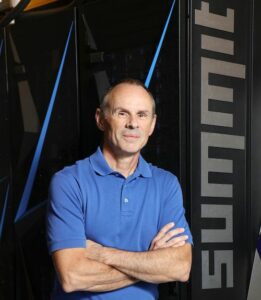Exascale Day Audio: John Turner
Impact Area: Additive Manufacturing

John Turner, Oak Ridge National Laboratory
Transcript
We’ve heard over the years about the loss of manufacturing capability in the US and especially today we hear a lot about supply chain issues. And there’s a set of technologies that are really revolutionizing manufacturing, and one of those is additive manufacturing, often referred to as just AM. In additive manufacturing, you take raw materials and you generate the parts on the fly. Specifically with metal AM, the raw material can be titanium powder or wire, and that’s melted by lasers or electron beams to create parts. The advantage of this is that you can make parts with more complexity, fewer components to assemble, and incredible control of the process. So, how does exascale computing fit into this?
Well, the properties of those parts such as the strength and the lifetime and fatigue behavior—those are determined by what is known as the microstructure of the parts, the size, the shape, the orientation of the grains that make up the metal, the material. And that microstructure is determined by the complex interaction of the physical phenomena of the manufacturing process: heat transfer, fluid flow, the cyclic melting and solidification of the metal itself. Understanding that complex interaction is key to being able to create parts using that additive manufacturing that will perform as we expect or as we need them to.
You can think of parts of automobiles or airplanes or day-to-day objects, but you want them to behave as we expect and you need properties. You need ductility or strength for different types of parts. So, we’ve been developing the simulation tools that will enable the understanding of those processes and how they interact. And exascale platforms such as Frontier and Aurora and El Capitan will allow us to predict the microstructure and properties of these complex parts with unprecedented detail and accuracy. We really can’t do that on the machines we have today. We’ve done a lot of run-up to that on pre-exascale systems such as Summit, but Frontier and those platforms are really going to enable much higher fidelity and much more predictive simulation of those processes.
Ultimately, this increased understanding will enable us to create faster-running models that can be used to accelerate the design and optimization of AM parts, even potentially running faster than real time, and we can use them to actually control the machines themselves that are creating these parts. So, really, it’s these exascale systems and the software, the simulation tools we’re developing, that are going to enable that huge leap in understanding.


